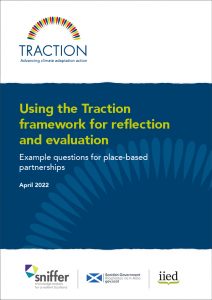Using the Traction framework for reflection and evaluation
Introduction
As a framework for advancing climate adaptation action, Traction can be used at a range of entry points – as a means for setting intentions, as a design tool, or as a stock take to enable reflection on and evaluation of adaptation progress.
This guidance sets out a five-stage process for using Traction as a reflective and evaluative tool. The outlined process reflects the approach undertaken in the Outer Hebrides, Scotland. The Traction framework was used by Sniffer, acting as a trusted intermediary, in collaboration with the Outer Hebrides Community Planning Partnership Working Group, to enable the group to reflect on their progress to date, and define next steps in their adaptation journey.
View the Outer Hebrides case study.
Whilst this process offers a guide for using Traction, it should not be seen as prescriptive – and should be adapted according to the local context and users.
Stage 1: Endorsement
First, the facilitator should review the Traction framework with the local partnership to consider whether the framework will help the group to understand what is enabling or inhibiting adaptation progress as a part of stock take, evaluation and strategy building exercise.
Actions:
- Facilitator shares the outline of the framework and the five enablers, and explains its use and purpose to the Partnership.
- Facilitator seeks endorsement by the partnership, collective agreement on the purpose of the use of Traction framework, and identifies a smaller working group to take the process forward.
Stage 2: Co-design
The facilitator can then use the five enablers within the Traction framework to create a set of questions to shape the process with the partnership. These questions should be tested and refined with members of the partnership to make sure they are relevant to their journey and appropriate for the local context. It is crucial that the questions create space for people to discuss what is important for them and their place.
Actions:
Facilitator develops key questions to support the partnership to reflect on progress in advancing climate adaptation in their place, barriers to progress and suggestions for looking forward, including on:
1. Partnership history, engagement and vision
2. How the work of the partnership links national frameworks and local realities
3. Cooperation, collaboration and engagement of different groups and priorities in climate action in the locality or region
4. How data is collected, used to inform knowledge, define plans
5. The functioning of the partnership
6. Equity and fairness within their context
7. Priorities and looking forward
Download a set of example questions
Stage 3: Conversations
The facilitator, working with the partnership, can then use the questions to guide a series of focus group discussions with members of the partnership. These groups should be structured to allow a range of voices to be heard, for example with different sessions for civil society organisations, local authority representatives, and local leaders, as well as mixed sessions to enable different organisations to listen and speak to one another.
Actions:
- Facilitator and partnership arrange focus group discussions either online or face to face that enable different voices to be heard: men, women, older and younger people, different organizations and backgrounds. Traction focus group discussions should engage 5-8 participants, and last around two hours, to allow people able to participate in a meaningful way. Safety in conversations needs to be assured, and the facilitator should make sure that group members actively listen to one another.
- The facilitator should provide at least two people to ensure facilitation and documentation for each discussion, including recording and transcribing the sessions.
Stage 4: Validation, generating insights and interpretation
The facilitator can then extract key messages that have emerged through Traction framework analysis from the recordings and transcripts to share with Traction participants to validate.
Actions:
- The facilitator gathers perspectives on policy coherence and leadership, developing pathways and how knowledge and information are used, cooperation and governance including who is and should be part of strategy building, climate justice and fairness
- The facilitator should then review findings with a small group of Traction participants from the partnership to validate and gather initial feedback, reflection and priorities.
- Traction participants from the partnership can then generate a briefing note on findings and ideas of what should happen next as a basis of sharing with the wider partnership
Stage 5: Documentation and shared analysis
The facilitator with Traction participants from the partnership, can then generate an evidence report to demonstrate what is working well – to be used as a part of communication – and what could be better to inform planning, policy and investments.
Actions:
- Facilitator generates initial reports on progress and areas for development taking into account
– Perspectives of stakeholders through Traction analysis
– Policy documents – these include strategies, frameworks, plans etc.
– Collaboration i.e. schemes and organisations that facilitate collaboration - Facilitator with Traction participants lead workshops and small working groups to analyse and progress identified priorities
- A report is generated consolidating findings and recommendations
- The partnership generates communication products such as stock take, press releases or reports to the public and the executive on progress and actions
Example: In the Traction pilot in the Outer Hebrides, participants identified short-, mid- and long-term priorities for the Climate Change Working Group including:
- Resourcing for the group functioning and coordination to enable enhance governance, and build a strategy for action through capacity to lead, development of pathways by gathering and utilising information and meaningful engagement with groups and communities
- The need for a shared vision and road map
- The need for enhanced communication and accountability on action
- The need for wider representation and enhanced engagement to inform analysis and planning
- The need to find ways to ensure the people and concerns of the locality or region are brought into the process


